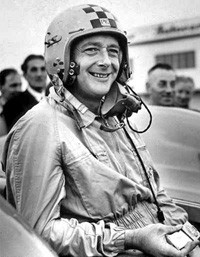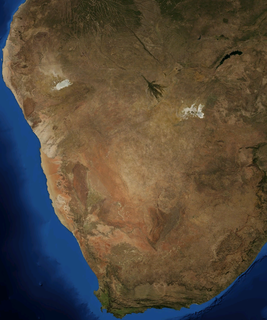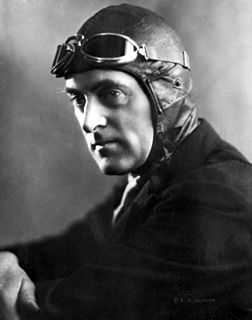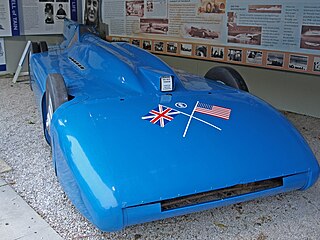
Donald Malcolm Campbell, was a British speed record breaker who broke eight absolute world speed records on water and on land in the 1950s and 1960s. He remains the only person to set both world land and water speed records in the same year (1964). He died during a water speed record attempt at Coniston Water in the Lake District, England.

The Kalahari Desert is a large semi-arid sandy savanna in Southern Africa extending for 900,000 square kilometres (350,000 sq mi), covering much of Botswana, and parts of Namibia and South Africa.

At 824,292 km2 (318,261 sq mi), Namibia is the world's thirty-fourth largest country. After Mongolia, Namibia is the second least densely populated country in the world. Namibia got its name from the Namib desert that stretches along the coast of the Atlantic. It is also known for its wildlife.

Major Sir Malcolm Campbell was a British racing motorist and motoring journalist. He gained the world speed record on land and on water at various times, using vehicles called Blue Bird, including a 1921 Grand Prix Sunbeam. His son, Donald Campbell, carried on the family tradition by holding both land speed and water speed records.
Wing Commander Andrew Duncan Green is a retired British Royal Air Force fighter pilot and World Land Speed Record holder since 1997, the first land speed record to break the sound barrier.

Royal Air Force Elvington or more simply RAF Elvington is a former Royal Air Force station which operated from the beginning of the Second World War until 1992 located at Elvington, Yorkshire, England.

Pendine Sands is a 7-mile (11 km) beach on the shores of Carmarthen Bay on the south coast of Wales. It stretches west to east from Gilman Point to Laugharne Sands. The village of Pendine is close to the western end of the beach.

The world unlimited Water Speed Record is the officially recognised fastest speed achieved by a water-borne vehicle, irrespective of propulsion method. The current unlimited record is 511.11 km/h (317.59 mph), achieved by Australian Ken Warby in the Spirit of Australia in 1978.

Bonneville Speedway is an area of the Bonneville Salt Flats northeast of Wendover, Utah, that is marked out for motor sports. It is particularly noted as the venue for numerous land speed records. The Bonneville Salt Flats Race Track is listed on the National Register of Historic Places.

The Sunbeam 350HP is an aero-engined car built by the Sunbeam company in 1920, the first of several land speed record-breaking cars with aircraft engines.
Rosco McGlashan OAM is an Australian drag racing record-holder, who currently holds the Australian land speed record at 500 mph (802.6 km/h). This record was set on the 27 March 1994 on the dry salt flats of Lake Gairdner, South Australia 440 km (270 mi) northwest of Adelaide.
The British land speed record is the fastest land speed achieved by a vehicle in the United Kingdom, as opposed to one on water or in the air. It is standardised as the speed over a course of fixed length, averaged over two runs in opposite directions.

The Napier-Campbell Blue Bird was a land speed record car driven by Malcolm Campbell. Its designer was C. Amherst Villiers and Campbell's regular mechanic Leo Villa supervised its construction.

The Campbell-Railton Blue Bird was Sir Malcolm Campbell's final land speed record car.

Bluebird K7 is a jet engined hydroplane which Britain's Donald Campbell set seven world water speed records between 1955 and 1967. K7 was the first successful jet-powered hydroplane, and was considered revolutionary when launched in January 1955. Campbell and K7 were responsible for adding almost 100 miles per hour (160 km/h) to the water speed record, taking it from existing mark of 178 miles per hour (286 km/h) to just over 276 miles per hour (444 km/h). Donald Campbell was killed in an accident with a much modified K7, on 4 January 1967, whilst making a bid for his eighth water speed record, with his aim to raise the record to over 300 miles per hour (480 km/h) on Coniston Water.
Bloodhound LSR, formerly Bloodhound SSC, is a British land vehicle designed to travel at supersonic speeds with the intention of setting a new world land speed record. The arrow-shaped car, under development since 2008, is powered by a jet engine and will be fitted with an additional rocket engine. The initial goal is to exceed the current speed record of 763 mph (1,228 km/h), with the vehicle believed to be able to achieve up to 1,000 miles per hour (1,609 km/h).

Kenhardt is a small town in the Northern Cape province of South Africa. This little town is about 120 km from Upington, the largest town in the area.
Brandvlei is a small town in the Karoo region of the Northern Cape, South Africa. This is where a 19th-century trekboer called Ou Brand settled. Brand camped at this spot at the Sakrivier, a dry river bed, which only occasionally had water after good rains – and which typically result in flash floods. The settlement was cut in two by such a flood in 1961. After it was recovered, a municipality was formed in 1962.

Jarvis & Sons Limited were South London-based motor dealers for Morris and MG, and latterly coachworks providing special bodies for various car chassis until after World War II.
Hakskeenpan is a mud and salt pan in the Kalahari Desert, in Southern Africa. It is located in the Mier region in the Northern Cape Province, in South Africa, at 801 meters (2,628 ft) above sea level. The pan covers an area of approximately 140 km2 (54mi2).



















